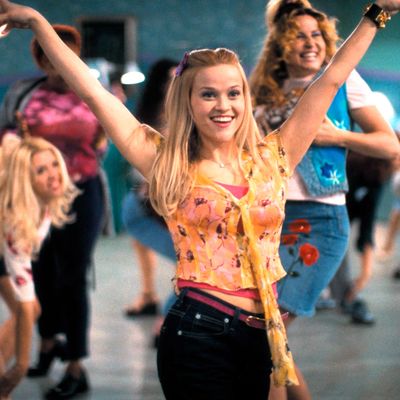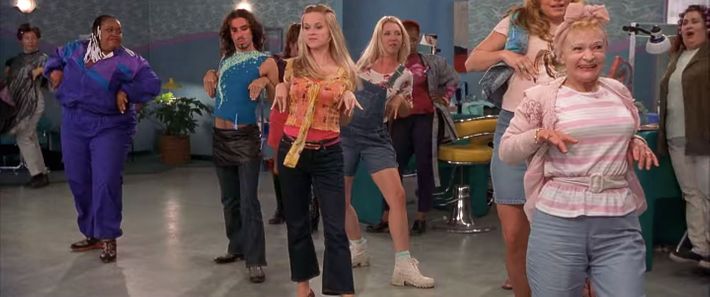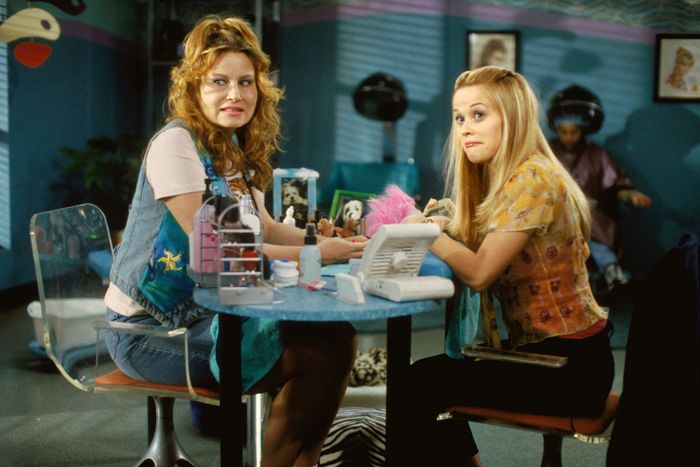
The phrase bend and snap began with a couple of mojitos.
With a nearly complete script on their hands, Legally Blonde writers Karen McCullah and Kirsten Smith were at the Viceroy L’Ermitage bar in Beverly Hills, and they were stuck. Producer Marc Platt had tasked the pair with conceptualizing a set piece for the movie’s B-plot, which centered on Harvard Law student Elle Woods and her lovesick manicurist, Paulette Bonafonté, who had been pining after a deliveryman for the majority of their story. This was before Jennifer Coolidge secured her iconic role, and the ideas were comically big. Does her salon get robbed? Does Paulette run into an immigration issue? “We were going in some different directions,” McCullah admits. Then inspiration struck. “I was like, ‘What if it’s just as simple as [Elle] teaching her a move to get the UPS guy?’”
Uninhibited thanks to the rum-based cocktails she’d been sipping, Smith suddenly hopped off her seat and began performing an attention-grabbing move. She extended her leg, bent down as if to snatch something and then quickly snapped her body upright. “I laughed so hard I almost fell off the barstool,” McCullah says. “The bartender probably stopped talking to us because he didn’t know what the fuck we were doing.” Shortly after, the pair were in Platt’s office showing him their idea. “I don’t mind making a fool of myself,” says Smith, who remembers Platt laughing at her. “I definitely felt like a very dorky dancer or wiggler, and it burped out of my psyche somewhere.”
Under director Robert Luketic’s guidance, the spontaneous two-part seduction would eventually become a full-on musical number, the words bend and snap inscribed in the pop-culture history books. The scene takes place midway through Legally Blonde, as Elle (Reese Witherspoon) aims to give Paulette (Coolidge) a jolt of confidence after an awkward encounter with her deliveryman crush (Bruce Thomas). Relaying a lesson from her mother, Elle explains the fundamentals of the “bend and snap,” a maneuver that boasts a “98 percent success rate of getting a man’s attention.” (And, not to mention, “when used appropriately, an 83 percent rate of return on a dinner invitation.”) Soon, Elle begins teaching the move to the entire salon, wherein a dance session (bursting with all kinds of bends and snaps) breaks into a joyous celebration. For just a few minutes, Legally Blonde turns into a surreal, candy-coated panorama.
Released 20 years ago, the movie remains a relevant feminist portrait of ditzy diligence, but the “bend and snap” lives on as a parallel phenomenon. Though it leads to an injurious payoff in the story (Paulette breaks a nose but gets her man), it stands as a silly and participatory punch line on its own, one that has been repurposed and revived for theatrical shows, music videos, and even Italian gay discos. For those involved in the scene — including a top-tier choreographer and several young actors and dancers — its creation feels just as magical, requiring weeks of rehearsals and shoots to reflect McCullah and Smith’s singular vision.
More Chicken Wings at the Top
Not long after Platt approved the “bend and snap” scene, Luketic began thinking musically. The director had just come off his 1997 short Titsiana Booberini, a musical-comedy that debuted at the Telluride Film Festival, and was eager to infuse Smith’s move into a dance sequence. Luketic hired Toni Basil — the veteran dancer responsible for “Hey Mickey” — to choreograph the short scene. Before she could get started, though, McCullah and Smith needed to show Basil their move, so they visited her dance studio to perform the basic mechanics. “[Toni] had other dancers there, and she was like, ‘All right, can you do it again? Watch her! More chicken wings at the top!’” Smith recalls. “I was like, ‘What is happening? This is so insane.’”
“That was the first and only time that the writers [of a movie] came over and showed me the choreography,” Basil says. “After that, I kind of ran with it.”
Basil began rounding up other dancers and conceiving choreography to accommodate a group. Originally, Luketic had asked for just women to appear in the sequence, but Basil pushed back. “Every hairdresser and salon has so many men,” she says, and a long-haired Ryan Heffington was cast to balance out the scene. Also at the top of Basil’s cast list was Faida Brigham, an accomplished dancer who had spent time in Basil’s African-dance class. A hospital supervisor in Long Beach, California, Brigham never pursued dance as a career but jumped at the chance to audition for Basil and be part of a Hollywood production. After booking the job, “I remember being in my office, and I screamed,” Brigham says. “I didn’t feel the whole gravity of it until I was at the screening watching me in the real movie.”
During the couple of weeks of rehearsals prior to shooting, Basil prompted Brigham to try a sabar step, a specific kind of Senegalese dance they had done in class. When shooting began, Basil gave her the spotlight. “She’d say ‘Okay, let’s give Faida a chance to do this alone.’ I was like, ‘Why is she singling me out?’” Brigham says. “She’d call out different steps. I would do my thing. At that point, when we kept doing it, I could see they were really taping this.”
“I always had my eye on her because she was always a spectacular African dancer, the best in the class,” Basil says. “She steals the scene.”
Dancers like Brigham were consummate professionals, but Basil worried that actors like Witherspoon might have trouble remembering the choreography, given the gap between rehearsals and the shooting of the scene. “She had to remember what we did from our preproduction time,” Basil says. Luckily, the scene — filmed at a real salon in Monrovia, California, and set to James Brown’s “Sex Machine” (later replaced with a remixed version of the song by Mya) — went so well, Witherspoon and all, that Luketic brought every dancer back for pickup shots, grabbing extra footage over another week of filming. “They shot it quite a few times from different angles, and the dancers never lacked energy,” McCullah remembers.
Watching from the set, Thomas was enthralled. As the hunky UPS driver, he sets the scene in motion by asking the smitten Paulette to sign a — rather, his — package. Cast after just one audition, Thomas suggested to Luketic a unique way of playing the character, and it stuck. “I just started playing around and started turning the tables on [Paulette],” Thomas says. “‘What if I came in, and I thought she was the most beautiful woman I’d ever seen?’” The interpretation harmonized with Coolidge’s comically awkward interactions, setting up their slow-motion, third-act encounter. “Her smile is one of our greatest natural resources,” Smith says.
To finish off the scene, Luketic brought in John Cantwell to play Maurice, a salon staff member who walks in on everyone dancing. “Oh my God, the ‘bend and snap’! Works every time!” he says before the camera cuts to two dogs barking in approval. “As a comedian and openly gay actor, there were a lot of one-liners,” he laughs of the Legally Blonde era. And although the sketch artist (now a drag queen) didn’t get a chance to show off his own bend, he appreciated the bit. “It just tells you — gay hairdressers, we know everything.”
Thank U, Next (Movie)
When Ariana Grande started conceiving ideas for her “thank u, next” music video in 2019, she originally gravitated toward Mean Girls, wanting to spin the movie’s signature “burn book” into a “gratitude book.” As she discussed the idea with director Hannah Lux Davis, the pair began listing their other favorite movies from that time period — Bring It On, 13 Going on 30, and Legally Blonde — and couldn’t resist merging them all into one video. “We kind of came up with this through-line that each character goes through some transformation and comes out on the other side wiser,” Davis says.
Grande and Davis decided a nail salon would be an ideal setting for portions of the video’s Legally Blonde tribute and quickly went about building an identical set filled with the same hair-dryers, garbage cans, and paintings. “We ended up using a trans light outside the windows to look like a street,” Davis says. “It took rewatching the film and studying the scene, and it was so fun to just go back and watch it with new eyes.” Along with a variety of background dancers, Coolidge eventually joined the shoot — Grande had built a relationship with her after Grande’s impression of the actress went viral — and suddenly the “bend and snap” (redubbed the “thank n next”) had new life. “[Paulette] was using what she already had and applying it in a whole new way,” Davis says of the scene’s alignment with Grande’s lyrics. “She didn’t change herself; she just made herself a better version of who she was.”
Upon the music video’s release, Smith was “gobsmacked” at the level of detail and, more generally, at the movie scene’s overall staying power. (The movie, which earned $141 million worldwide against its $18 million budget, “appeals to younger girls now because it’s all about female empowerment and taking down the patriarchy,” McCullah says.) Cantwell says he still gets recognized for his line at drag performances, and his only regret is that Luketic cut down the scene considerably. “It was a full-on production number,” he says. “Look at all the shapes and sizes and ages of people. Everyone’s having fun. My dream has always been that one day they’ll do this big director’s vision.”
Of course, it remains a possibility that the “bend and snap” will return in Legally Blonde 3, which Smith and McCullah say is still in development after they wrote an initial draft. But even they admit it would be nearly impossible to do justice to the alchemy of the original, an 11th-hour idea that continues to prove timeless. “It was getting down to the wire,” Smith says. “Thank goodness for mojitos.”



